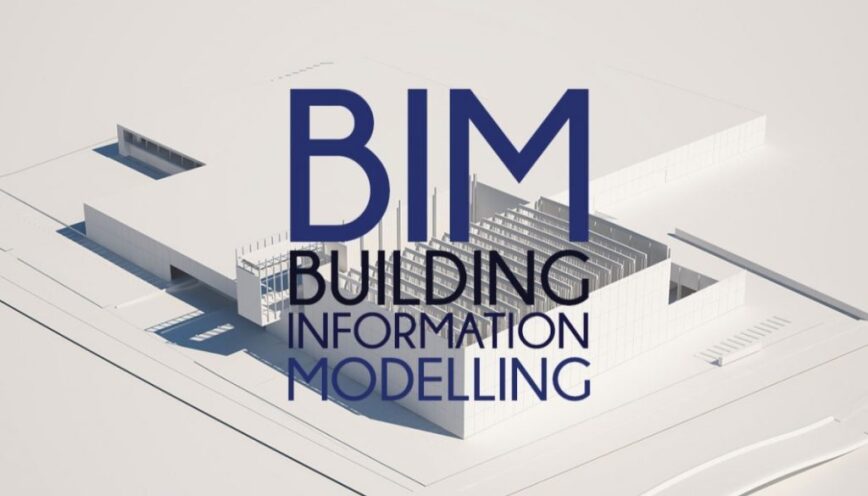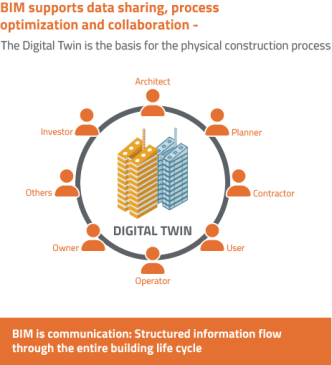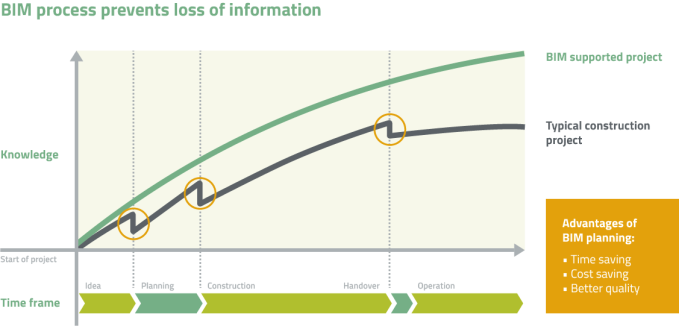BIM definition and history:
Building Information Modeling (BIM) describes a digital holistic working method for the networked planning, execution and management of buildings. It enables the creation, management and updating of precise three-dimensional building models. The models contain all relevant data of a construction,these range from planning and construction to operation and maintenance. BIM enables stakeholders to respond to problems or changes at an early stage. In this way, the entire life cycle of a building can be designed more efficiently.
The introduction of 3D modeling and computer-aided design (CAD) software in the 1980s laid the foundation for BIM. The term "Building Information Modeling" was first used by Jerry Laiserin 2002 to describe the integrative approach of bringing together information and technologies in construction.
Since then, BIM has quickly become the industry standard, driven by the constant evolution of digital technologies and the growing demands for efficiency and sustainability in construction. Today, the digital working method is an essential part of modern construction and is used worldwide to give all parties involved in the project a better overview and control of the entire process. The resulting planning certainty means reduced costs for investors. "BIM is communication," says BIM expert Karsten Spieß, "the resulting benefits are increased planning reliability, high transparency, end-to-end information quality, increased schedule and cost reliability, building lifecycle consideration, improved handover to the operational phase and much more. The transparent exchange of BIM data and information between all project participants is the key to success. This makes it possible to always keep a close eye on the respective construction project across all construction phases."
BIM planning - areas of application
BIM is used in various sectors of the construction industry, for example in architecture, civil engineering, building technology and facility management.
Architecture:
Architects use BIM to create and visualize accurate 3D models of buildings. This allows them to develop and optimize their designs more efficiently and communicate better with other project stakeholders.
Construction:
BIM promotes collaboration between the various project stakeholders. In addition, more accurate planning and control of costs, schedules and resources are possible, resulting in greater efficiency in the implementation of construction projects.
Building services engineering (TGA -Technical Building Equipment):
Engineers use the BIM methodology to integrate systems such as heating, ventilation, air conditioning, electrical engineering, building automation or plumbing into the building model. BIM enables better coordination of the technical trades and helps to identify and resolve potential conflicts at an early stage.
Facility management:
BIM supports facility management by providing detailed information about the condition and functions of buildings and their facilities. This allows maintenance and repair work to be planned and carried out more efficiently, extending service life and reducing operating costs. Despite different application areas, they all have a common goal: to optimize the entire life cycle of a building through the efficient use of digital information and technologies.
Building Information Modeling (BIM) - Pre-Construction Process

What does BIM data represent?
Data is the core of any BIM project. It represents a large amount of information that can be collected and used throughout the lifecycle of a building. It is information about the physical and functional characteristics of the building that can be represented in the form of 3D models. In addition, BIM models can be enriched with other information, such as details about materials, location, geometry, cost, schedule, maintenance requirements and much more. The levels of detail are subdivided into different BIM dimensions.
Data quality is crucial for the use of BIM data. BIM data must be accurate, up-to-date, consistent and interoperable to be used effectively in different BIM tools and processes. Furthermore, it should be provided in a format that is compliant with relevant BIM norms and standards to enable optimal collaboration and efficient data exchange.
In addition, it is also important that BIM data can be used throughout the lifecycle of a building or infrastructure. Starting from the initial concept phase, through design, construction and operation, to deconstruction or refurbishment. This makes BIM data a valuable resource for anyone involved in any phase of the lifecycle of a building or infrastructure facility.


Using BIM also simplifies collaboration between stakeholders. Working on the same model prevents information loss. This is because all relevant data and information are linked to the model.
Norms and standards in BIM modeling
A number of norms and standards have been developed to ensure smooth collaboration and effective information sharing in the application of BIM. These standards can be divided into the two approaches OpenBIM and ClosedBIM. These differ in whether vendor-independent or proprietary standards are used for BIM planning. The most important standards and norms are:
ISO 19650:
The international standard ISO 19650 (Parts 1 and 2) establishes the fundamentals for information management in construction using BIM. It provides requirements and guidelines for organizing and digitizing information about construction works.
IFC (Industry Foundation Classes):
IFC is an open, international standard for data exchange of BIM models. It enables interoperability between different BIM software applications and ensures correct data transfer between stakeholders.
COBie (Construction Operations Building Information Exchange):
COBie is a standard for the exchange of building information. The goal is to capture and manage building-specific data throughout the lifecycle. COBie simplifies the transfer of information for facility management and maintenance.
VDI3805:
VDI3805 is a standard issued by the Association of German Engineers (VDI). It defines a product data interface for technical building equipment (TGA). Its aim is to improve digital interoperability between different systems and applications in the field of building services engineering. It provides a standardized approach for the description, exchange and use of product data. This makes the planning, installation and maintenance of technical building equipment more efficient. For BIM users, VDI3805 enables more accurate and efficient planning and execution of building services projects through standardized product data. However, it is mainly used in Germany and represents only a part of the BIM data standards.
VDI 2552:
The VDI 2552 series of guidelines creates a structured approach for the effective implementation of BIM in the design, construction and operation of buildings. It combines all the internationally proven rules of technology to date as well as all the basic information on BIM, such as uniform terms, data management or classification systems, and much more. A uniform understanding of terms and processes is necessary for a target-oriented and comprehensible project process. The guideline therefore applies on the one hand to all those involved in BIM processes and on the other hand to manufacturers of software or components, auditors, experts and tenderers.
DIN EN 17412-1:
With the introduction of the standard, the existing concept of Level of Detail (also Level of Development, LOD) is replaced by the new term "Level of Information in Needs" (LOIN). LOD describes the information content of the digital building models LOIN records alphanumeric requirements and the necessary documents. DIN EN 17412-1 (Building information modeling - Level of information in needs - Part 1: Concepts and principles) is aimed at all those involved in the life cycle of a building, i.e. planners, specialist tradesmen, owners and so on.
LOD (Level of Development):
LOD is a standard that describes the level of detail of BIM models and divides them into different levels. There is currently no binding definition for levels of detail. LOD defines the extent to which information (LOI) and geometry (LOG) must be available in a specific project phase and serves as a guide for all project participants. In addition, BIM services can be better calculated, since modeling and data acquisition efforts are easier to understand.
LOIN (Level of Information Need):
The term "Level of Information Need" was already introduced with ISO 19650-1 to define information services and described in more detail with the new European standard series DIN EN 1742 1. The focus of the LOIN is on the information needs of the digital building model. It is not a simple replacement for the LOD concept. The client defines the LOIN as part of a call for tenders, and this serves as the basis for the subsequent agreements and specifications of the parties involved. During the course of the project, the LOIN is further developed - always adapted to the respective stakeholder and the respective phase.
BIM software for modeling and planning
There are various BIM software solutions and tools for the different requirements and focal points of the users. A central element of many BIM projects is the Common Data Environment (CDE), which serves as a common platform for storing, managing and exchanging relevant project information. The following is a brief introduction to some of the leading BIM software applications and their unique features, including their integration into a CDE:
Autodesk Revit:
Autodesk Revit is one of the most well-known and widely used BIM software. It supports collaboration between architects, engineers and contractors and enables the creation of detailed 3D models. Revit offers features for architecture, building engineering and construction.
Graphisoft Archicad:
Archicad is a powerful BIM software designed specifically for architects. It allows to create 3D building models and coordinate an efficient design, execution and operation phase. The software is known for its user-friendly interface and fast modeling capabilities.
Allplan:
Allplan is another BIM software solution for architects and engineers. It offers functions for the creation of 3D models, the design of structures, and the exchange and coordination of information. Allplan is particularly valued for its precise modeling and integration of engineering structures.
Bentley Systems:
Bentley Systems offers a range of BIM solutions tailored to different areas of civil engineering. The best known is MicroStation, a versatile platform for creating 3D models and managing building information. Bentley's products are particularly known for their scalability and adaptability to large, complex projects.
liNear:
liNear is BIM software focused on building services engineering (BBE) design. The solution supports the design, coordination and integration of heating, ventilation, air conditioning, electrical and plumbing systems. The software enables the creation of detailed 3D models of TGA installations and supports collaboration between planners and contractors.
SOLAR-COMPUTER:
SOLAR-COMPUTER is a software solution that is specially tailored to the requirements of technical building equipment (TGA). It is used to plan and calculate solar thermal, photovoltaic and heating systems. SOLAR-COMPUTER enables precise predictions of the energy efficiency and profitability of building projects through the comprehensive integration of environmental and building data. The software provides special tools and functions for planning and optimizing solar thermal and photovoltaic systems. In addition, heating and cooling systems can be simulated and analyzed taking into account various factors such as building characteristics, geographic location, and meteorological conditions.
CARF:
CARF is a CAD software suitable for complete factory design and technical building equipment, among other applications. CARF offers a wide range of products, such as the fire protection layout, the furnishing layout or the building layout designer and many more. The software is constantly being expanded and adapted to current conditions.
TRICAD:
TRICAD MS is a 3D CAD software for TGA and facility planning based on Bentley Systems. Planning information is embedded in the software, so downstream processes can use and integrate this data for the realization of BIM or Digital Twins.
Haustech CAD:
Haustech CAD offers a versatile solution package. The design software is suitable for the design of building services systems and assists with the multi-layered requirements in BIM, plumbing, heating, ventilation and plumbing systems. Models can be designed in 2D or 3D.
Large project planned with BIM
Projects planned with BIM are no longer an exception - but unfortunately still too rare. An example of a major project that was completely handled with BIM is Viega World. Building Information Modeling was used to create a Digital Twin of the building, making it possible to plan the construction and operating process and subsequent disposal. The transfer of planning data to the digital model made it possible to correct any problems before the building was constructed. The entire life cycle of the new building was taken into account during planning, with a focus on sustainability, and it was also possible to plan ahead for later deconstruction using BIM. Building Information Modeling can therefore be used to save costs and resources, among other things, and to shorten project durations.
Conclusion
Building Information Modeling (BIM) has the potential to profoundly change and improve the construction industry. By using BIM, the design, construction and operation of buildings can be made more efficient and sustainable. Collaboration between different project stakeholders is facilitated and the entire lifecycle of a building is optimized. This process is supported by various BIM software solutions and tools that offer specialized functions for different application areas.
In the future, BIM and the construction industry will evolve to meet increasing demands for efficiency, sustainability and innovation. One of the challenges will be to further promote the use of BIM technologies and to continuously improve collaboration between different stakeholders. In addition, the integration of new technologies such as artificial intelligence, virtual reality and the Internet of Things (IoT) will play an important role in the further development of BIM in order to derive the maximum benefit from this revolutionary method.